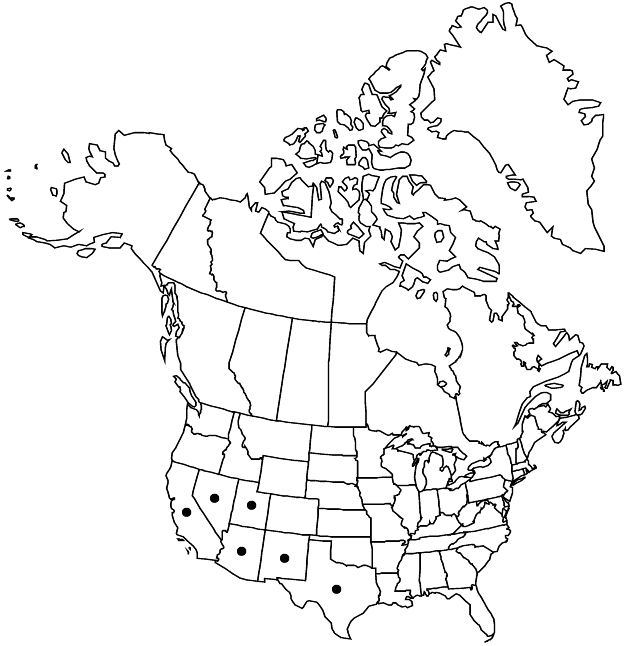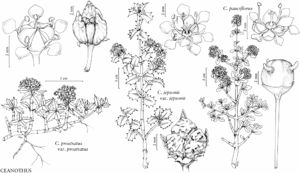Difference between revisions of "Ceanothus pauciflorus"
Prodr. 2: 33. 1825.
FNA>Volume Importer |
FNA>Volume Importer |
||
| Line 15: | Line 15: | ||
|name=Ceanothus greggii | |name=Ceanothus greggii | ||
|authority=A. Gray | |authority=A. Gray | ||
| − | }}{{Treatment/ID/Synonym | + | }} {{Treatment/ID/Synonym |
|name=C. greggii var. franklinii | |name=C. greggii var. franklinii | ||
|authority=S. L. Welsh | |authority=S. L. Welsh | ||
| − | }}{{Treatment/ID/Synonym | + | }} {{Treatment/ID/Synonym |
|name=C. vestitus | |name=C. vestitus | ||
|authority=Greene | |authority=Greene | ||
| Line 36: | Line 36: | ||
|elevation=900–2900. | |elevation=900–2900. | ||
|distribution=Ariz.;Calif.;Nev.;N.Mex.;Tex.;Utah;n;c Mexico. | |distribution=Ariz.;Calif.;Nev.;N.Mex.;Tex.;Utah;n;c Mexico. | ||
| − | |discussion=<p>Ceanothus pauciflorus as circumscribed here includes plants having flat to cupped leaf blades with a sparse to dense but not intertwined indumentum composed of short curly or wavy hairs, at least when young; this indumentum also occurs on the petiole and ultimate branchlets. Such plants in the United States have been treated either as C. greggii or C. vestitus (M. Van Rensselaer and H. McMinn 1942). However, R. McVaugh (1998) and D. O. Burge and K. Zhukovsky (2013) provided evidence that they should be treated as C. pauciflorus. Specimens from the desert slopes of the Sierra Nevada and San Bernardino Mountains, California, and a few scattered localities in western Arizona, have leaves similar in shape and dentation to those of C. perplexans, suggesting local hybridization.</p> | + | |discussion=<p><i>Ceanothus pauciflorus</i> as circumscribed here includes plants having flat to cupped leaf blades with a sparse to dense but not intertwined indumentum composed of short curly or wavy hairs, at least when young; this indumentum also occurs on the petiole and ultimate branchlets. Such plants in the United States have been treated either as <i>C. greggii</i> or <i>C. vestitus</i> (M. Van Rensselaer and H. McMinn 1942). However, R. McVaugh (1998) and D. O. Burge and K. Zhukovsky (2013) provided evidence that they should be treated as <i>C. pauciflorus</i>. Specimens from the desert slopes of the Sierra <i>Nevada</i> and San Bernardino Mountains, California, and a few scattered localities in western Arizona, have leaves similar in shape and dentation to those of <i>C. perplexans</i>, suggesting local hybridization.</p> |
|tables= | |tables= | ||
|references= | |references= | ||
| Line 60: | Line 60: | ||
|publication year=1825 | |publication year=1825 | ||
|special status=Selected by author to be illustrated | |special status=Selected by author to be illustrated | ||
| − | |source xml=https://jpend@bitbucket.org/aafc-mbb/fna-data-curation.git/src/ | + | |source xml=https://jpend@bitbucket.org/aafc-mbb/fna-data-curation.git/src/8f726806613d60c220dc4493de13607dd3150896/coarse_grained_fna_xml/V12/V12_630.xml |
|genus=Ceanothus | |genus=Ceanothus | ||
|subgenus=Ceanothus subg. Cerastes | |subgenus=Ceanothus subg. Cerastes | ||
Revision as of 15:48, 18 September 2019
Shrubs, 0.2–2 m, sometimes moundlike. Stems erect or weakly ascending to spreading, not rooting at nodes; branchlets light gray to ashy gray, rigid, puberulent to tomentulose, hairs curly or wavy, glabrescent. Leaves not fascicled; petiole (0–)1–3 mm; blade flat to ± cupped, elliptic, oblong-elliptic, obovate, or suborbiculate, 5–15(–20) × 3–14(–15) mm, base cuneate to rounded, margins thick, not revolute, entire or remotely denticulate, teeth 1–5(–7), apex acute to ± truncate, abaxial surface pale green to grayish green, glabrate or puberulent, hairs curly or wavy, glabrescent, adaxial surface grayish green, puberulent, hairs curly or wavy, glabrescent. Inflorescences axillary, rarely racemelike, 0.7–3 cm. Flowers: sepals and petals white to cream, sometimes pale blue or lavender; nectary yellowish green, brown, or blue. Capsules 3.5–6 mm wide, not, or sometimes weakly, lobed; valves smooth, horns lateral, prominent to minute or absent, spreading, intermediate ridges absent.
Phenology: Flowering Feb–May.
Habitat: Rocky slopes, ridges, alluvial fans, sagebrush and montane shrublands, pinyon and/or juniper and montane conifer woodlands.
Elevation: 900–2900.
Distribution

Ariz., Calif., Nev., N.Mex., Tex., Utah, n, c Mexico.
Discussion
Ceanothus pauciflorus as circumscribed here includes plants having flat to cupped leaf blades with a sparse to dense but not intertwined indumentum composed of short curly or wavy hairs, at least when young; this indumentum also occurs on the petiole and ultimate branchlets. Such plants in the United States have been treated either as C. greggii or C. vestitus (M. Van Rensselaer and H. McMinn 1942). However, R. McVaugh (1998) and D. O. Burge and K. Zhukovsky (2013) provided evidence that they should be treated as C. pauciflorus. Specimens from the desert slopes of the Sierra Nevada and San Bernardino Mountains, California, and a few scattered localities in western Arizona, have leaves similar in shape and dentation to those of C. perplexans, suggesting local hybridization.
Selected References
None.
